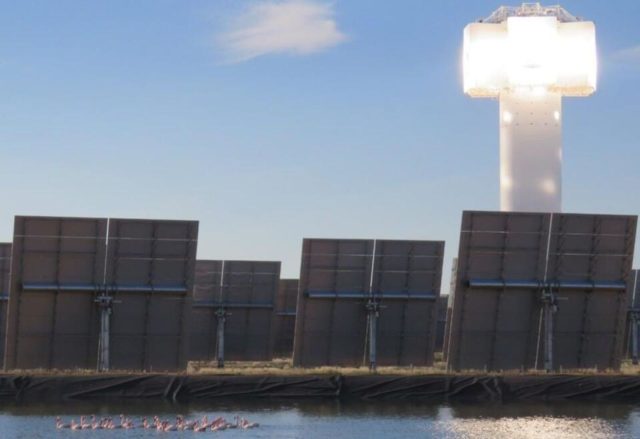A masters student at Stellenbosch University has done a study on the impact that solar power towers have on bird populations by focusing on birdlife around the Khi Solar One facility near Upington in the Northern Cape.
A MASTERS student at Stellenbosch University has done a study on the impact that solar power towers have on bird populations by focusing on birdlife around the Khi Solar One facility near Upington in the Northern Cape.
A student at the university’s Department of Conservation Ecology and Entomology, HP van Heerden’s study was the first to focus on birdlife around the Khi Solar One facility.
Van Heerdan, who matriculated from Upington High School in 2003, received his MSc in Conservation Ecology from Stellenbosch University earlier this year.
According to Van Heerden, his fieldwork showed that the solar tower does have an impact on the typical bird populations found in the area but less so than expected.
“When considering renewable energy options, one must always consider the pros and the cons for the environment and the impact it may have on the plants and animals,” Van Heerden explained the rationale behind his study.
Van Heerden took his lead from similar studies previously done in the USA and Spain. He did surveys on the solar tower site of 315 hectares, as well as on adjacent open veld.
Throughout two seasons he recorded all bird species in sight. This included 57 different species in total and 2 380 individual birds. In winter 49 species were recorded, none of which were of conservation importance, while the only birds of conservation importance noted in summer were lanner falcons (a vulnerable species).
“More species (53 against 45) were observed in the adjacent veld than around the solar tower site itself,” Van Heerden pointed out. “Most species flew no higher than 10m, the exception being pied crows, Egyptian geese and korhaan.”
He also found that birds were less inclined to breed on the site and around the buildings. “On the site itself four sociable weaver nests and those of a korhaan, two dove species, a Namaqua sandgrouse and a southern common fiscal were recorded.”
Van Heerden pointed out that the erection of the solar tower had an influence on the composition of bird species typically found in the area.
“Evaporation ponds attracted water birds such as flamingos which had not previously been found on the farm where it had been built. Wood and shrubland species, as well as species usually found in urban areas, are nowadays found in greater numbers around the tower area than in the adjacent veld.”
Van Heerden also surveyed the area for possible fatalities and injuries. “A total of 324 injured or fatally injured birds (representing 34 species) were recorded around the greater solar tower.
Of these, 285 were found inside the heliostat area (the so-called solar field) and the rest around the power generation unit and the evaporation ponds. Sixty-one percent of incidents were caused by birds colliding into structures, while 14% of birds were singed.”
His study found that most dead birds were seed-eating resident birds like the red-billed quelea and lark-like bunting which are fairly common in the area. “Apart from one lanner falcon and one white pelican, no birds of conservation importance were among the casualties.”
Camera traps showed that some of the dead birds were eaten by pied crows, Cape foxes and yellow mongooses.
“Most birds collided against structures in the area where the freestanding heliostats are, and mostly along the lower quarter of these structures, roughly 3.2 m above the ground, involving the last two panels of each heliostat,” Van Heerden explained. “That’s at about the normal flight height of birds like red-headed finches and lark-like buntings.”
Most incidents occurred early in the morning or around sundown when birds are most active.
According to Van Heerden, the collisions possibly occurred when the heliostats stand at a 90-degree vertical position for a limited period during sunrise and after sunset. “It creates the illusion of an unbroken landscape and can completely confuse the birds,” he reasoned.
Most often it was migrating birds and species that hunt their prey in the air that were fatally singed during summer months by the so-called solar flux – a concentrated beam of sunlight that radiates from the heliostats past the central receiver and can reach temperatures up to 800 degrees Celsius.
“The bright light radiating from the mirrors of the towers can attract insects and, in the process, also insect-eating birds,” continued Van Heerden. “When something like a moving bird perhaps flies through the solar flux, it can be singed because the sunlight from the heliostats collides with an object and is converted into thermal energy.”
Most of the singeing incidents were recorded during a time that the heliostats were not in use, owing to power plant downtime. The heliostats stood in a standby position, which resulted in a kind of halo effect and singeing (solar flux) in the air above the tower.
According to some media reports from the USA, up to one bird per minute (which would amount to 28 000 birds per year) could die due to solar towers.
“My findings do not support such claims. These are more likely made based on anecdotal evidence rather than good data.”
“Based on data from the current study, these claims seem exaggerated,” Professor Karen Esler, one of van Heerden’s study leaders and chair of Stellenbosch University’s Department of Conservation Ecology and Entomology said. “For perspective on the real impact of solar towers, one should compare bird fatalities around the site with those caused by other human activities in the area, such as farming, mining or the road network.”
A study conducted in 2014 estimated that between 98 million and 980 million birds die annually in the United States after colliding into buildings or windows. Up to 3.7 billion are caught by cats, and between 89 million and 340 million die because of traffic-related incidences.
“Some impact by solar towers on the environment is almost unavoidable, but can be minimised if managed right,” reasoned Van Heerden.
The study recommends to operators of CPS facilities that heliostats should not be positioned at exactly 90 degrees during early mornings and late afternoons when birds are most active.
“The intensity of the concentrated energy or solar flux radiating out above solar towers could be reduced when the heliostats are in standby position and not operational. Heliostats should also preferably be set in a horizontal position when solar power is not being generated by the facility.”








